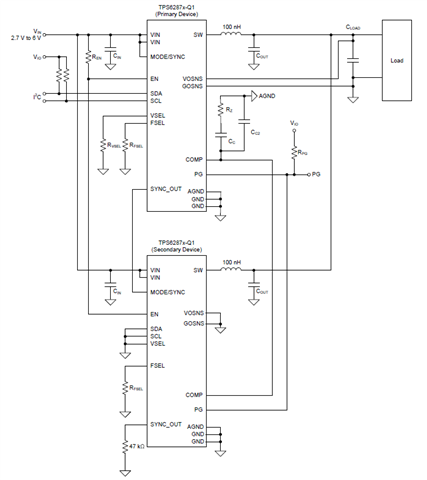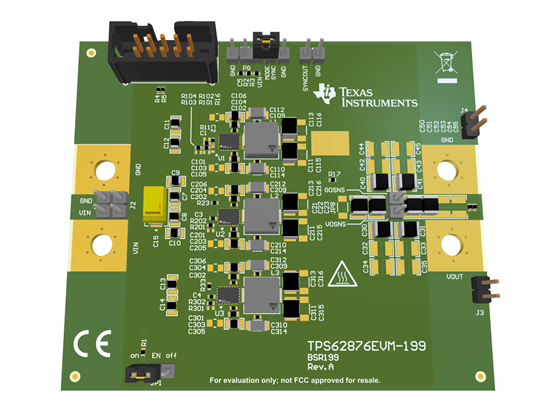-
How to deliver current beyond 100 A to an ADAS processor SSZTCY4 June 2023 TDA4AH-Q1 , TDA4AP-Q1 , TDA4APE-Q1 , TDA4VH-Q1 , TDA4VP-Q1 , TDA4VPE-Q1 , TPS62874-Q1 , TPS62875-Q1 , TPS62876-Q1 , TPS62877-Q1
-
How to deliver current beyond 100 A to an ADAS processor
How to deliver current beyond 100 A to an ADAS processor
Canan Priess
The electrification of vehicle systems is growing in advanced driver assistance systems (ADAS), which include vision analytics for autonomous driving, parking assistance and adaptive control functions. Smart connectivity, safety-critical software applications, and neural network processing all require enhanced computing power in real time.
Meeting these advanced needs requires a multicore processor such as the TDA4VH-Q1, which can support electronic control units (ECUs) beyond 100 A. But the design challenges associated with high power include achieving efficiency for higher current rails, controlling thermal performance and load transients at full loads, and meeting functional safety requirements.
Delivering ADAS processing power
The TPS62876-Q1 buck converter helps designers address currents beyond 30 A with a novel stackability feature that achieves the high currents necessary to power a system-on-a-chip (SoC) such as the TDA4VH-Q1. The family includes devices ranging from 15 A to 30 A, available in the same package, and Stack feature that can support to reach load current beyond 100A.
Stacking these devices not only helps power the core of next-generation ADAS SoCs, but also helps improve thermal performance by reducing thermal limitations, and increase efficiency. See Figure 1.
 Figure 1 Two TPS62876-Q1 devices in a
stacked configuration
Figure 1 Two TPS62876-Q1 devices in a
stacked configurationStacking operates by using the daisy-chain method. The primary device controls one compensation network, one POWERGOOD pin, one ENABLE pin and one I2C interface. For optimal current sharing, you must program all devices in the stack to use same current rating, the same switching frequency and the same current level.
The primary device in the stack also sets the output voltage and controls its regulation. If there is a 47-kΩ resistor between the SYNCOUT pin and ground, the device operates as a secondary device. If the SYNCOUT pin is high impedance, the device operates as a primary device. Figure 2 shows the stack configuration implemented on a printed circuit board.
 Figure 2 Example evaluation module of
three stacked TPS62876-Q1 buck converter
Figure 2 Example evaluation module of
three stacked TPS62876-Q1 buck converterOther features in this family of buck converters include:
- Droop compensation, also known as load line (automatic voltage positioning). Scaling the nominal output voltage provides better load-transient tolerance based on the output current (15 A to 30 A) and helps reduce the output capacitance, enabling a cost-optimized, high-power-density solution. The REGISTER pin enables or disables droop compensation, which is disabled by default.
- Remote sensing supports a wider range of SoC processors with a tighter output-voltage requirement that provides more headroom during load transients. The device’s remote sense lines connect directly to the point of load, which allows you to set the voltage with an accuracy of 0.8%.
- The I2C interface monitors system performance and sends a warning if the temperature and output current exceed specified limits. It is also possible to use dynamic voltage scaling to adjust the output voltage from 0.4 V to 1.675 V. If you do not need the I2C feature, you can still use same device by connecting the SCL and SDA pins to ground.
Functional safety
Functional safety is an important aspect in ADAS, especially when it comes to autonomous driving. The TPS62876-Q1 buck converter offers TI Functional Safety-Capable levels of documentation, which include:
- The functional safety failure-in-time rates of the semiconductor component estimated by the application of industry reliability standards.
- Component failure modes and their distribution based on the device’s primary function.
- Pin failure-mode analysis.
Adding an external supervisor to your design enables you to achieve Automotive Safety Integrity Level standards.
Conclusion
Moving toward higher autonomy levels such as Society of Automotive Engineers Level 2 will require more computational capabilities to provide higher resolutions and quick responses in a very short time. Embedding features such as artificial intelligence technologies also increases the need for more power-hungry ADAS SoC processors. The stackability of the TPS62876-Q1 family helps you achieve core power beyond 100 A to enable a higher level of autonomous driving.
Additional resources
- Read the technical article, “Minimize the Impact of the MLCC Shortage on Your Power Application.”
- Download the TPS6287x-Q1 data sheet.
- Check out the “TPS62876 Buck Converter Evaluation Module” user’s guide.
- See the TPS62874-Q1, TPS62875-Q1, TPS62876-Q1 and TPS62877-Q1 Functional Safety FIT Rate, FMD and Pin FMA functional safety information.
- Find the right Arm®-based processor for your automotive needs.
IMPORTANT NOTICE AND DISCLAIMER
TI PROVIDES TECHNICAL AND RELIABILITY DATA (INCLUDING DATASHEETS), DESIGN RESOURCES (INCLUDING REFERENCE DESIGNS), APPLICATION OR OTHER DESIGN ADVICE, WEB TOOLS, SAFETY INFORMATION, AND OTHER RESOURCES “AS IS” AND WITH ALL FAULTS, AND DISCLAIMS ALL WARRANTIES, EXPRESS AND IMPLIED, INCLUDING WITHOUT LIMITATION ANY IMPLIED WARRANTIES OF MERCHANTABILITY, FITNESS FOR A PARTICULAR PURPOSE OR NON-INFRINGEMENT OF THIRD PARTY INTELLECTUAL PROPERTY RIGHTS.
These resources are intended for skilled developers designing with TI products. You are solely responsible for (1) selecting the appropriate TI products for your application, (2) designing, validating and testing your application, and (3) ensuring your application meets applicable standards, and any other safety, security, or other requirements. These resources are subject to change without notice. TI grants you permission to use these resources only for development of an application that uses the TI products described in the resource. Other reproduction and display of these resources is prohibited. No license is granted to any other TI intellectual property right or to any third party intellectual property right. TI disclaims responsibility for, and you will fully indemnify TI and its representatives against, any claims, damages, costs, losses, and liabilities arising out of your use of these resources.
TI’s products are provided subject to TI’s Terms of Sale (www.ti.com/legal/termsofsale.html) or other applicable terms available either on ti.com or provided in conjunction with such TI products. TI’s provision of these resources does not expand or otherwise alter TI’s applicable warranties or warranty disclaimers for TI products.
Mailing Address: Texas Instruments, Post Office Box 655303, Dallas, Texas 75265
Copyright © 2023, Texas Instruments Incorporated